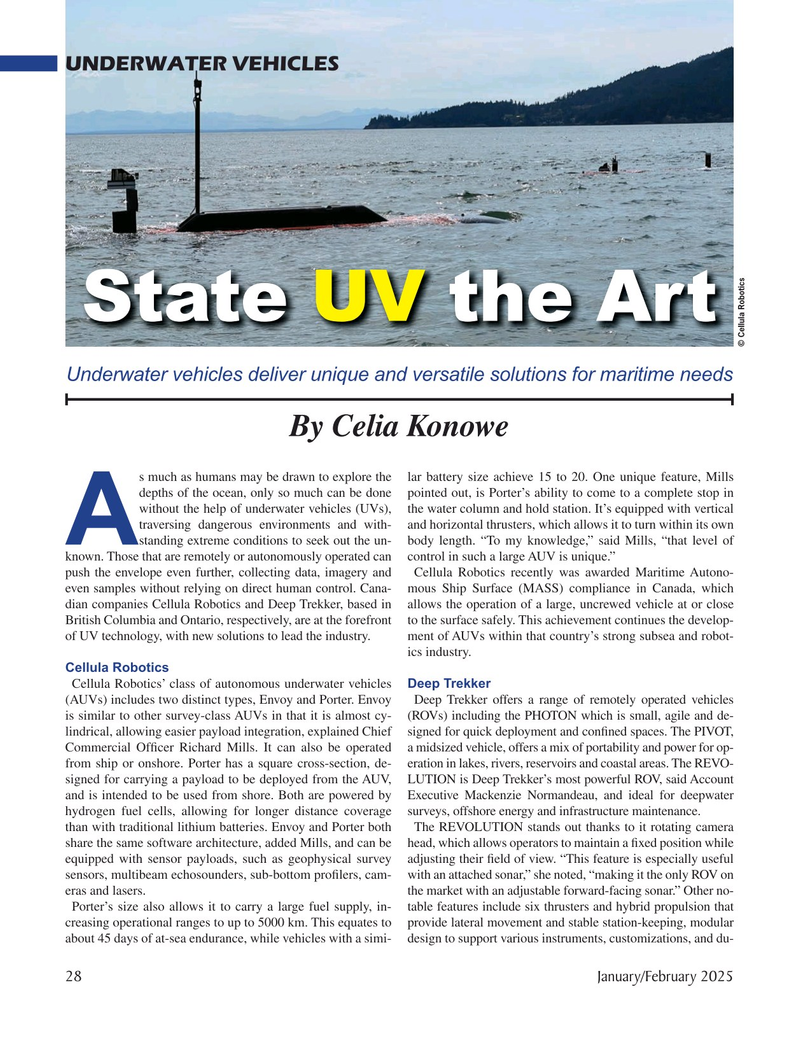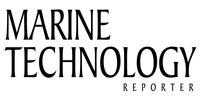
Page 28: of Marine Technology Magazine (January 2025)
Read this page in Pdf, Flash or Html5 edition of January 2025 Marine Technology Magazine
UNDERWATER VEHICLES
State UV the Art © Cellula Robotics
Underwater vehicles deliver unique and versatile solutions for maritime needs
By Celia Konowe s much as humans may be drawn to explore the lar battery size achieve 15 to 20. One unique feature, Mills depths of the ocean, only so much can be done pointed out, is Porter’s ability to come to a complete stop in without the help of underwater vehicles (UVs), the water column and hold station. It’s equipped with vertical traversing dangerous environments and with- and horizontal thrusters, which allows it to turn within its own
Astanding extreme conditions to seek out the un- body length. “To my knowledge,” said Mills, “that level of known. Those that are remotely or autonomously operated can control in such a large AUV is unique.” push the envelope even further, collecting data, imagery and Cellula Robotics recently was awarded Maritime Autono- even samples without relying on direct human control. Cana- mous Ship Surface (MASS) compliance in Canada, which dian companies Cellula Robotics and Deep Trekker, based in allows the operation of a large, uncrewed vehicle at or close
British Columbia and Ontario, respectively, are at the forefront to the surface safely. This achievement continues the develop- of UV technology, with new solutions to lead the industry. ment of AUVs within that country’s strong subsea and robot- ics industry.
Cellula Robotics
Cellula Robotics’ class of autonomous underwater vehicles Deep Trekker (AUVs) includes two distinct types, Envoy and Porter. Envoy Deep Trekker offers a range of remotely operated vehicles is similar to other survey-class AUVs in that it is almost cy- (ROVs) including the PHOTON which is small, agile and de- lindrical, allowing easier payload integration, explained Chief signed for quick deployment and con? ned spaces. The PIVOT,
Commercial Of? cer Richard Mills. It can also be operated a midsized vehicle, offers a mix of portability and power for op- from ship or onshore. Porter has a square cross-section, de- eration in lakes, rivers, reservoirs and coastal areas. The REVO- signed for carrying a payload to be deployed from the AUV, LUTION is Deep Trekker’s most powerful ROV, said Account and is intended to be used from shore. Both are powered by Executive Mackenzie Normandeau, and ideal for deepwater hydrogen fuel cells, allowing for longer distance coverage surveys, offshore energy and infrastructure maintenance.
than with traditional lithium batteries. Envoy and Porter both The REVOLUTION stands out thanks to it rotating camera share the same software architecture, added Mills, and can be head, which allows operators to maintain a ? xed position while equipped with sensor payloads, such as geophysical survey adjusting their ? eld of view. “This feature is especially useful sensors, multibeam echosounders, sub-bottom pro? lers, cam- with an attached sonar,” she noted, “making it the only ROV on eras and lasers. the market with an adjustable forward-facing sonar.” Other no-
Porter’s size also allows it to carry a large fuel supply, in- table features include six thrusters and hybrid propulsion that creasing operational ranges to up to 5000 km. This equates to provide lateral movement and stable station-keeping, modular about 45 days of at-sea endurance, while vehicles with a simi- design to support various instruments, customizations, and du- 28 January/February 2025
MTR #1 (18-33).indd 28 2/3/2025 9:57:14 AM

 27
27

 29
29
